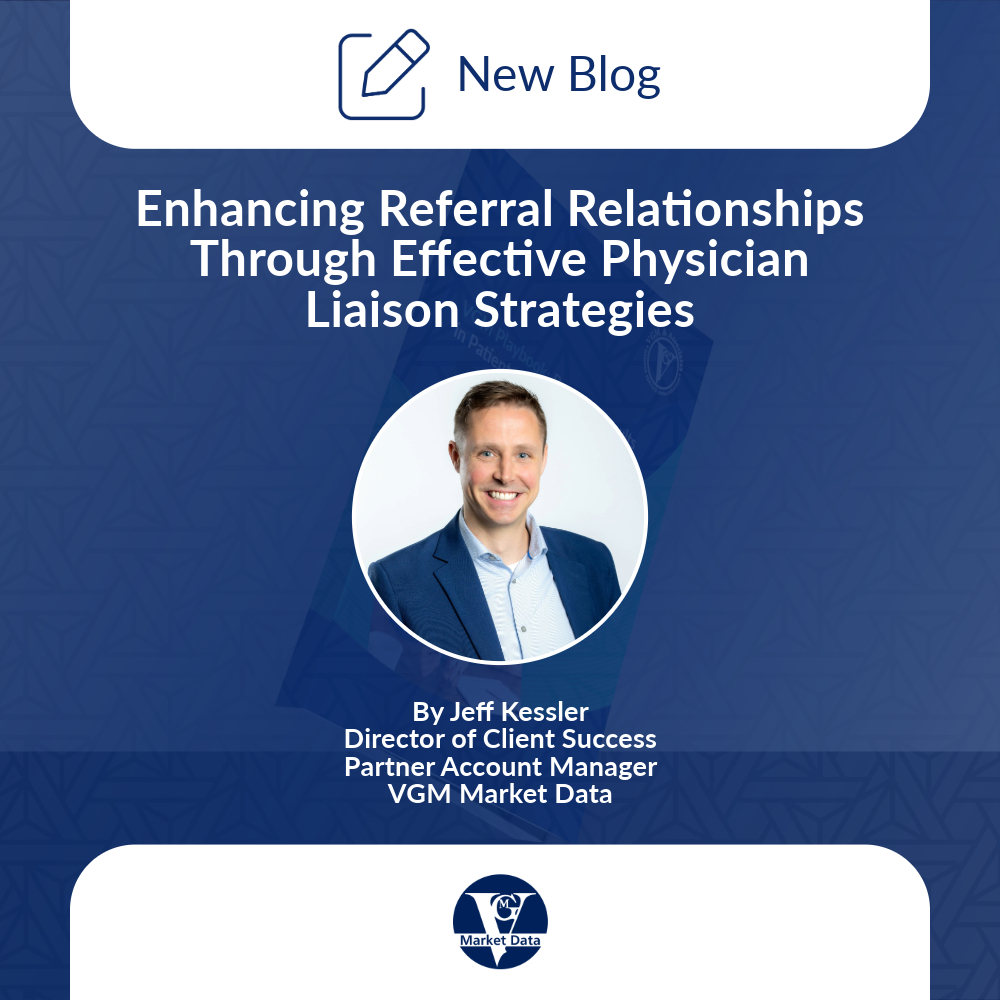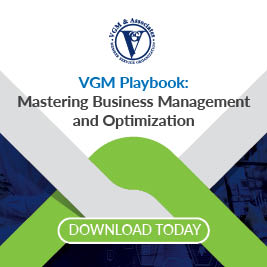Enhancing Referral Relationships Through Effective Physician Liaison Strategies
Published in
Complex Rehab
on November 19, 2024
 By Jeff Kessler, Director of Client Success, Partner Account Manager, VGM Market Data
By Jeff Kessler, Director of Client Success, Partner Account Manager, VGM Market Data
In today’s dynamic healthcare environment, the importance of nurturing relationships with referral sources cannot be overstated. An effective physician liaison strategy is essential for sustained success. Here are some of the keys to building and maintaining these crucial connections.

The Importance of Referral Relationship
Relying on a single referral source is a high-risk strategy. Physicians retire and relocate. Employers can change health plans, potentially moving a large swath of your business to another DME. Market disruptions, cyber security incidents, and labor and supply shortages all can impact referral sources you rely on for business, making ongoing referral marketing your safety net. The healthcare landscape is ever-changing, with mergers and acquisitions reshaping the field. Proactive engagement helps you stay ahead. When referrals seem automatic, it’s easy to become complacent. Regular engagement ensures these relationships flourish. Physicians are your customers, and they deserve a dedicated service plan to feel valued and supported. If you don’t prioritize this, your competition will.
The Role of a Physician Liaison
Physician liaisons, referral liaisons, ambassadors, etc., are pivotal in generating and maintaining referrals. Their responsibilities include actively seeking new opportunities, ensuring existing referring doctors are satisfied, addressing any concerns, and implementing the initial logistics of the referral processes. This role bridges the gap between the healthcare providers and your business, ensuring a seamless flow of patient care from their administrative staff to yours.
Strategies for Physician Liaisons
Personal Engagement
An effective strategy for physician liaisons typically involves personal engagement through face-to-face interactions. Understanding each physician’s or office’s preferences is key. Tailoring your approach based on the time and attention you receive, whether it’s a minute or half an hour, is crucial. Addressing common issues like patient callbacks and streamlining processes to be a reliable partner in patient care is essential.
Follow-up Touches
After initial in-person introductions, setting up a regular cadence of communication keeps referral sources engaged and informed. Regular check-ins and updates on patient status help maintain a strong relationship. Tracking your activities using a customer relationship management (CRM) tool can help monitor engagement.

Building Trust and Improving Operations
Building trust and improving operations involves discussing strengths and weaknesses with referring physicians. This not only enhances your operations but also builds trust. Using patient data to provide meaningful insights to physicians helps them save time and improve patient care. Different physicians and offices have unique needs, so customizing your approach to fit each one is important. This tailored strategy ensures that each interaction is relevant and valuable, fostering a deeper connection with your referral sources.

Delivering Real Value
Delivering real value means increasing your medical knowledge to speak the same language as physicians. You don’t need to be a clinician, but you should be an expert. It’s not just about dropping off treats. While lunches and small gifts have their place, focus on providing real value through medical knowledge and understanding of the practice. Building relationships with front desk staff is important, but finding the decision maker is key. Sometimes that’s the physician or referral manager. Be persistent and respectful. Focus on genuine engagement rather than bribery. Physicians appreciate valuable interactions over treats and lunches. Be willing to wait and show your dedication, demonstrating the importance of your message.
Overcoming Challenges
Some offices may be difficult to penetrate, so persistence and a well-thought-out strategy are key. Not every attempt will be successful, so know when to move on and focus on more promising opportunities. Identify your current, past, and potential referral sources. Build trust by understanding their needs and providing excellent patient care. Regularly check in to ensure satisfaction and address any issues. Use a CRM tool to monitor interactions and outcomes.
Scaling Your Business
Focus on building relationships with middle-tier referral sources to create a stable foundation. Use feedback to refine your processes and ensure sustainable growth. Avoid being too eager or desperate. Consistent, value-driven interactions are key. This approach not only secures a steady stream of referrals but also establishes a reputation for reliability and excellence in patient care.
Professionalism and Ethics
Professionalism and ethics play a significant role in the success of a physician liaison. Be aware of current inducement rules. While you may not be able to bring in bagels, you can invite physicians to your office after work for informal discussions over wine or hors d’oeuvres. This allows you to showcase new technology or products in a relaxed setting. The occupational therapy rehab space demands higher ethical standards, so always maintain professionalism. Traditional sales tactics like “wine and dine” are less effective today. When asking for someone’s time, ensure you have valuable content to share. Be prepared and respectful of their time. Clearly communicate your role and expertise. Be honest, earn respect, and provide valuable feedback.

Using Physician Claims Data to Create an Efficient Strategy
Leveraging physician claims data can significantly enhance your strategy by providing insights into referral patterns, patient demographics, and treatment outcomes. This data allows you to identify high-value referral sources and tailor your approach accordingly. By analyzing claims data from services like VGM Market Data, you can pinpoint which physicians are most likely to refer patients to your practice and understand their specific needs and preferences. This targeted approach ensures that your efforts are focused on the most promising opportunities, maximizing your efficiency and effectiveness. This information enables you to align your services with the needs of referring physicians, demonstrating your value as a partner in patient care. Tracking outcomes helps you provide evidence of your effectiveness, further strengthening your relationships with referral sources.
Measuring Success
Measuring success as a physician liaison involves tracking various metrics and outcomes that reflect your effectiveness in building and maintaining referral relationships. Key metrics include referral volume and growth, physician satisfaction, retention rates, order turnaround time, compliance rates, frequency of contact, response time, data presentation, and customized solutions. Additionally, professional development, revenue growth, market share, anecdotal feedback, and case studies are important indicators of success. Regularly tracking these metrics and reflecting on your performance can help you continuously improve your strategies and ensure long-term success.

Additional Insights
Incorporating insights from industry experts can further enhance your strategy. For instance, providing data such as compliance rates, order turnaround time, and patient setup speed helps demonstrate efficiency and reliability. Simplifying prescription and order processes with customized order forms can reduce administrative time. Understanding meeting preferences, such as breakfast meetings before clinic hours or dinner meetings, can help tailor your approach. Engaging with both doctors and nursing staff, depending on the office size and volume, shows value to nurses by being the clinical experts.
A typical week for a physician liaison involves sales calls, cold calling, and setting appointments. Respect their time and show up prepared. Stand out from other sales reps by being mindful of their time, having a set agenda, and presenting data in an easily understood format. Measure success by the number of orders received and the time taken to secure the first order. Maintain regular touchpoints, such as weekly updates and monthly in-person meetings, to present collected data. Identify and address common office pain points, such as lack of communication and patient complaints. Document all interactions and be transparent about any issues to build trust.

Final Thoughts
A successful physician liaison strategy is about more than just generating referrals. It’s about building lasting relationships, providing exceptional service, and continuously adapting to the changing healthcare landscape. By focusing on these elements and incorporating industry insights, you can ensure a steady stream of referrals and a strong network of trusted partners. This holistic approach not only enhances patient care but also solidifies your position as a valuable and reliable partner in the healthcare community.
READ THE FULL ARTICLE HERE
 This article was originally featured in the VGM Playbook: Mastering Business Management and Optimization. To read the full article and more like this, download your copy of the playbook today!
This article was originally featured in the VGM Playbook: Mastering Business Management and Optimization. To read the full article and more like this, download your copy of the playbook today!
TAGS
- market data
- playbook
- referral sources
- vgm